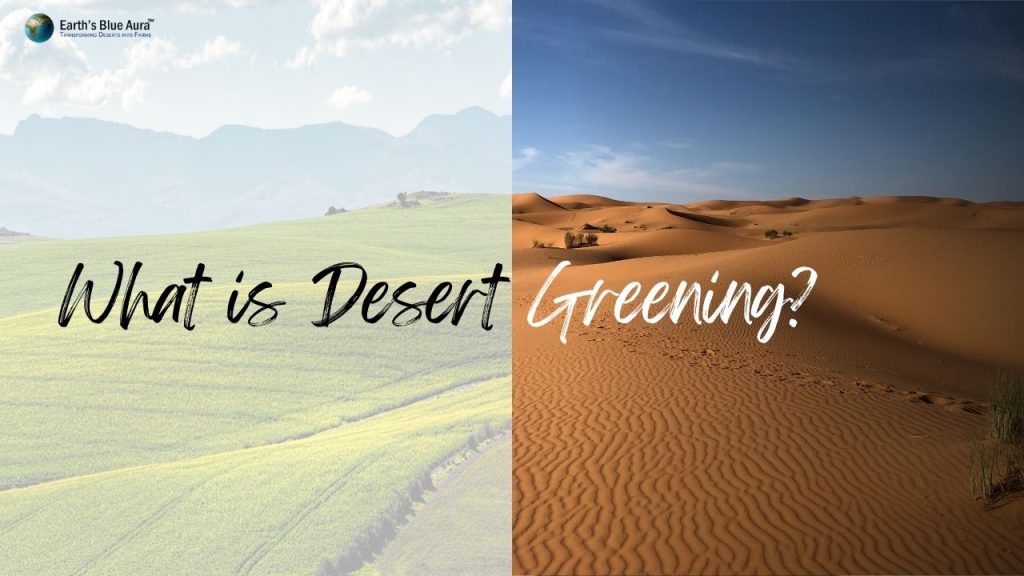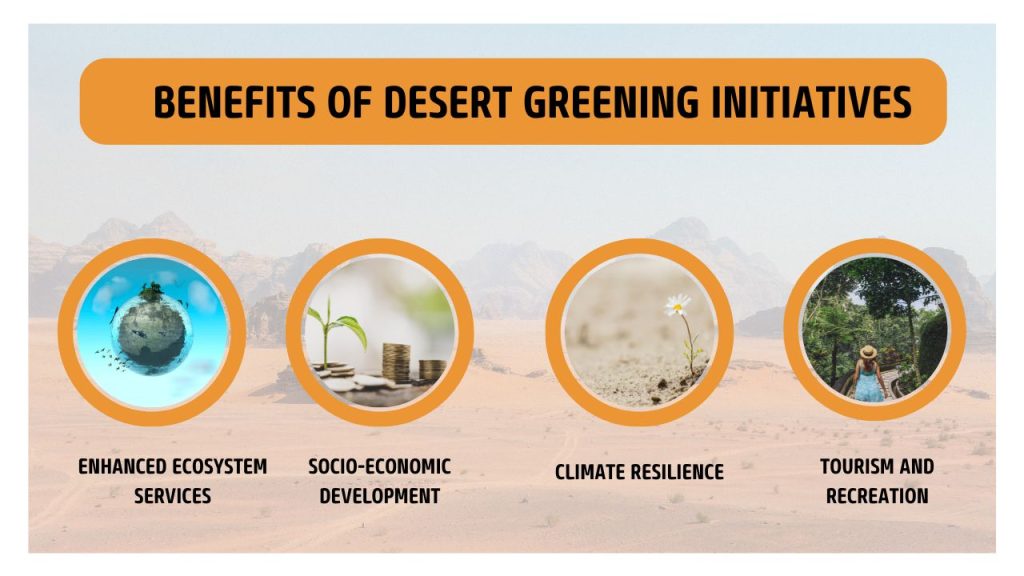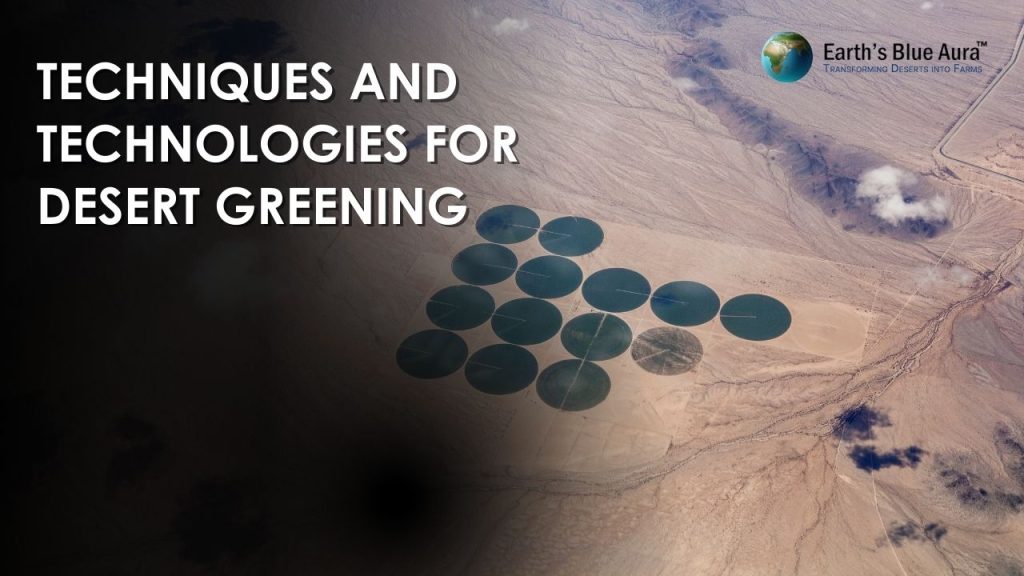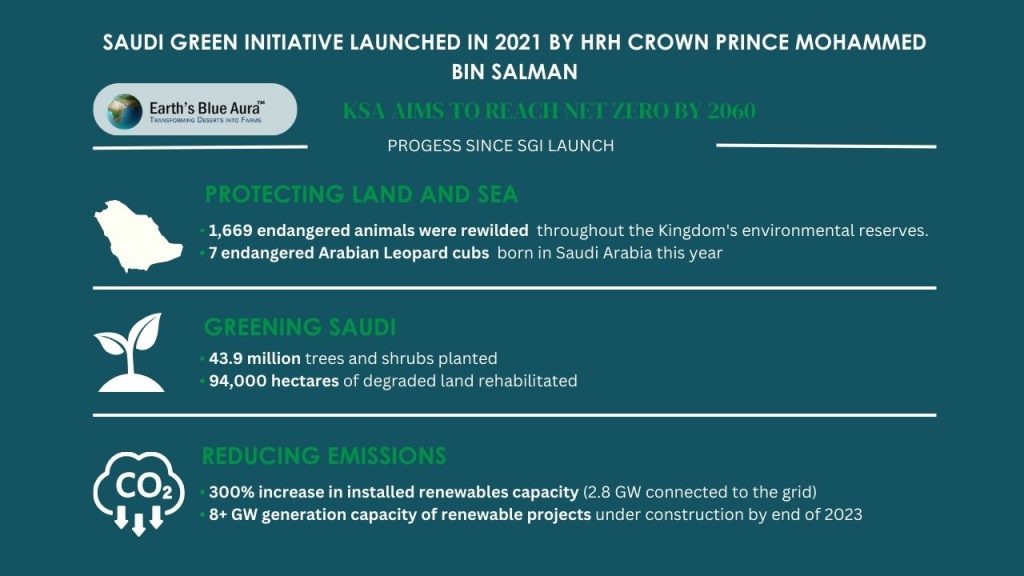Desert greening is like a light in the dark, helping us fight big environmental problems like deserts spreading, climate change, and animals and plants disappearing. It’s when we turn dry places into green, useful areas. This not only brings back nature but also helps people living there.
Saudi Arabia is famous for its huge deserts. It’s started big projects to turn these deserts green. This shows the country really cares about nature, wants to make its economy more diverse, and make sure there’s enough food and water for everyone.
This blog is all about Saudi Arabia’s work on desert greening. We’ll talk about different things they’re doing to make deserts better, like using new ideas and old ways to save water. We want to show you how Saudi Arabia is working hard to make deserts bloom with life again. So, come with us as we explore these sandy lands and find the green spots growing among the dunes.
What is Desert Greening?

Desert greening means making dry places green and useful. We do this by planting trees, taking care of the soil, and managing water better. The main aim is to bring back nature, stop deserts from spreading, and make homes for plants, animals, and people to live in sustainably.
Transforming Desert Greening Landscapes
In recent years, there has been a notable shift in efforts to transform desert landscapes, particularly in regions like Saudi Arabia. With growing awareness of environmental issues and the potential impact of climate change, there is a renewed focus on greening arid areas. This transformation involves various strategies, including afforestation, water conservation, and sustainable land management practices. By harnessing technology and innovation, countries are striving to turn once-barren deserts into thriving ecosystems, demonstrating a commitment to environmental sustainability on a global scale.
Importance of Desert Greening for Environmental Sustainability
Desert greening is really important for keeping our environment healthy. Here’s why:
- Stopping desert spread: Desert greening helps to stop dry areas from spreading, which can happen when the land becomes less useful due to things like climate change and people using it in a bad way.
- Saving plants and animals: By making deserts green, we create homes for lots of different plants and animals. This helps keep our environment diverse and balanced.
- Taking in carbon: When plants grow in greened deserts, they take in carbon dioxide from the air. This helps to lessen the effects of climate change by removing some of the harmful gases from the atmosphere.
- Using water wisely: Desert greening projects often use smart ways to manage water, like collecting rainwater and recycling wastewater. This helps to make sure water is used efficiently and not wasted in places where it’s really scarce.
Benefits of Desert Greening Initiatives

Desert greening initiatives yield a wide array of benefits, including:
- Enhanced ecosystem services: Greening deserts improves soil fertility, reduce soil erosion, and enhance water infiltration, leading to increased agricultural productivity and food security.
- Socio-economic development: By creating green spaces and supporting agricultural activities, desert greening projects generate employment opportunities, improve livelihoods, and stimulate local economies.
- Climate resilience: Vegetation cover resulting from desert greening helps mitigate the impacts of climate change by stabilizing microclimates, reducing heat stress, and preventing sand and dust storms.
- Tourism and recreation: Greened desert landscapes attract tourists and nature enthusiasts, offering opportunities for eco-tourism, outdoor recreation, and cultural experiences.
The Context of Desert Greening in Saudi Arabia
Overview of Saudi Arabia’s Desert Landscape
Saudi Arabia mostly has huge deserts, like the Rub’ al Khali, which is one of the biggest sand deserts globally. It doesn’t rain much there, and the weather is dry, making it hard for plants to grow and for farming to happen. The desert has lots of sand dunes, rocky areas, and gravel plains, with only a few plants that can survive in such tough conditions.
Challenges Posed by Desertification in Saudi Arabia
Desertification poses significant challenges in Saudi Arabia, exacerbated by factors such as:
- Limited water resources: With water scarcity being a critical issue, the country faces challenges in sustaining agriculture and supporting ecosystems in arid regions.
- Soil degradation: Wind and water erosion, coupled with unsustainable land use practices, contribute to soil degradation, reducing its fertility and productivity.
- Climate change impacts: Rising temperatures and changing precipitation patterns exacerbate desertification, leading to increased aridity and desert encroachment into fertile lands.
- Biodiversity loss: Habitat destruction and degradation threaten the survival of native plant and animal species adapted to desert environments, impacting ecosystem stability and resilience.
Government Initiatives and Policies Promoting Desert Greening
Saudi Arabia started some projects and rules to help stop deserts from spreading and make them green:
The “Green Saudi Initiative” and the “Green Middle East Initiative”: These are plans from the Saudi government to plant lots of trees and make green places all over Saudi Arabia and nearby areas. The goal is to stop deserts from getting bigger, make more kinds of plants and animals live there, and lessen the effects of climate change.
- Sustainable agriculture programs: The government has invested in sustainable agriculture practices, including drip irrigation, aquifer recharge, and the cultivation of drought-resistant crops, to improve food security and preserve water resources in arid regions.
- Afforestation and reforestation projects: Large-scale afforestation and reforestation projects are underway, utilizing native and adapted tree species to establish green corridors, stabilize sand dunes, and restore degraded ecosystems.
- Water conservation measures: The government promotes water conservation through the implementation of efficient irrigation techniques, wastewater recycling, and desalination technologies to optimize water use in agricultural and urban areas.
With these plans and rules, Saudi Arabia wants to make the deserts better and help people and nature. They want to make sure the deserts don’t get worse and become green places for everyone to enjoy. This shows that Saudi Arabia cares about making the environment better for people now and in the future.
Techniques and Technologies for Desert Greening

Soil Rejuvenation Technology: Overview and Significance
Deep Soil Rejuvenation Technology involves techniques to improve soil quality and fertility in arid regions. This may include soil aeration, addition of organic matter, and introduction of beneficial microorganisms to enhance soil structure and nutrient content. Deep soil rejuvenation methods penetrate below the surface, reaching the root zones of plants and promoting healthy growth.
Soil rejuvenation is vital for desert greening projects as it creates a conducive environment for vegetation growth. By improving soil moisture retention, nutrient availability, and root penetration, rejuvenated soil supports the establishment and sustainability of plant life in arid landscapes. This technology is particularly crucial for afforestation and reforestation efforts in desert areas, where soil quality may be poor due to desertification and erosion.
Water Harvesting Techniques: Maximizing Water Resources
Rainwater harvesting systems collect and store rainwater for later use in irrigation and other purposes. In desert regions with limited rainfall, capturing rainwater becomes essential for supporting vegetation and agricultural activities. Techniques include rooftop harvesting, surface runoff collection, and construction of storage tanks and cisterns to store harvested rainwater for dry periods.
Fog nets and dew harvesting systems capture moisture from fog and dew, providing a supplementary water source in arid environments. Mesh nets or structures are installed to intercept fog droplets, which then condense and drip into collection containers. Dew harvesting involves similar principles, with surfaces designed to condense moisture from the air overnight. These techniques can be particularly effective in coastal and high-altitude desert areas where fog and dew occur frequently.
Sustainable Agriculture Practices: Cultivating Life in the Desert
Drip irrigation delivers water directly to the root zone of plants, minimizing water wastage through evaporation and runoff. This efficient water management technique is well-suited for desert environments, where water resources are scarce. By providing precise amounts of water to individual plants, drip irrigation promotes optimal growth while conserving water, making it a cornerstone of sustainable agriculture in arid regions.
Agroforestry integrates trees and shrubs into agricultural landscapes, offering multiple benefits such as soil conservation, biodiversity enhancement, and microclimate regulation. In desert greening projects, agroforestry systems can provide shade, windbreaks, and organic matter to improve soil fertility and create microhabitats for flora and fauna. Sustainable crop cultivation techniques, including drought-resistant crop varieties and crop rotation, further support agricultural productivity in desert environments while minimizing environmental impact.
Successful Case Studies in Saudi Arabia
Al-Ahsa Oasis: Restoring an Ancient Oasis
The Al-Ahsa Oasis project aims to restore and preserve one of the world’s largest natural oases, located in the Eastern Province of Saudi Arabia. Spanning over 10,000 hectares, the Al-Ahsa Oasis boasts a rich cultural heritage and biodiversity, with thousands of date palm trees and agricultural terraces dating back thousands of years. The project involves sustainable management practices, including water conservation, soil rejuvenation, and traditional farming techniques, to revive and safeguard this vital ecosystem.
The greening efforts in the Al-Ahsa Oasis have had a significant impact on local communities and ecosystems. By restoring the oasis, the project has revitalized agricultural livelihoods, providing employment opportunities and income generation for residents. Additionally, the increased vegetation cover has enhanced biodiversity, supporting various plant and animal species endemic to the region. Moreover, the oasis serves as a cultural and recreational hub, attracting tourists and fostering a sense of pride and identity among local communities.
Riyadh Green Project: Urban Greening for a Sustainable Future
The Riyadh Green Project focuses on transforming the urban landscapes of Saudi Arabia’s capital city into green, sustainable environments. This ambitious initiative involves planting millions of trees, creating parks, and implementing green infrastructure projects across Riyadh. By incorporating green spaces into urban planning and development, the project aims to mitigate the effects of urban heat islands, improve air quality, and enhance the overall quality of life for residents.
Community involvement and engagement are integral to the success of the Riyadh Green Project. The project encourages active participation from residents, businesses, and local organizations through initiatives such as tree planting campaigns, community gardening projects, and environmental education programs. By involving the community in greening efforts, the project fosters a sense of ownership and responsibility towards environmental conservation and sustainable development in Riyadh.
These successful case studies in Saudi Arabia demonstrate the transformative power of desert greening initiatives, from restoring ancient oases to greening urban landscapes. Through proactive management, community engagement, and innovative approaches, these projects exemplify Saudi Arabia’s commitment to environmental sustainability and greening the desert for future generations.
Future Prospects and Challenges
Potential for Expansion: Scaling Up Desert Greening Efforts
The potential for expansion in desert greening efforts is vast, both within Saudi Arabia and globally. With increasing recognition of the importance of combating desertification and promoting environmental sustainability, there is growing momentum for scaling up greening initiatives. Saudi Arabia, with its extensive desert landscapes and ambitious green initiatives, is well-positioned to lead the way in expanding desert greening projects. By leveraging its resources, expertise, and partnerships, the kingdom can further enhance its role in greening the desert and inspiring similar efforts worldwide.
The Saudi Green Initiative
At the forefront of desert greening efforts is the Saudi Green Initiative, launched as part of the kingdom’s broader vision for sustainable development. This ambitious initiative aims to plant billions of trees, reduce carbon emissions, and promote renewable energy sources. With the goal of restoring natural ecosystems and mitigating the effects of climate change, the Saudi Green Initiative represents a significant step towards realizing the prophetic vision of Arabia’s desert greening. By leveraging its resources and expertise, Saudi Arabia seeks to set an example for other nations and inspire collective action towards a greener, more sustainable future.

Technological Advancements and Innovations in Desert Greening
Technological advancements offer promising opportunities for enhancing desert greening efforts. Innovations such as precision agriculture, remote sensing, and drone technology enable more efficient monitoring and management of greening projects. Biotechnology and genetic engineering hold potential for developing drought-resistant plant varieties better suited to arid environments. Additionally, emerging techniques like vertical farming and hydroponics offer alternative approaches to agricultural production in desert regions. By embracing these advancements, desert greening initiatives can become more effective, sustainable, and resilient in the face of environmental challenges.
Addressing Challenges Such as Water Scarcity and Climate Change Resilience
Despite the progress made in desert greening, challenges such as water scarcity and climate change resilience remain significant hurdles. Continued efforts to develop and implement innovative water management strategies are essential for maximizing water resources in arid regions. This includes investing in desalination technologies, wastewater recycling, and efficient irrigation practices. Additionally, enhancing climate change resilience through ecosystem-based adaptation measures, such as reforestation and habitat restoration, can help mitigate the impacts of changing climatic conditions on desert ecosystems.
Conclusion
Desert greening holds immense significance for Saudi Arabia, a country predominantly characterized by vast desert landscapes. From combating desertification and preserving biodiversity to enhancing food security and promoting socio-economic development, desert greening initiatives play a vital role in addressing environmental challenges and securing a sustainable future for the kingdom. By restoring degraded ecosystems, maximizing water resources, and fostering green innovation, Saudi Arabia can unlock the full potential of its desert landscapes while safeguarding the well-being of its people and the planet.
As we reflect on the importance of desert greening for Saudi Arabia, it is crucial to recognize the ongoing need for support and investment in greening initiatives. Governments, organizations, and individuals must continue to prioritise desert greening efforts through policy commitments, funding allocations, and community engagement. By rallying collective action and fostering partnerships, we can accelerate progress towards greening the desert and achieving our shared environmental goals.
Let us envision a future where the Saudi Arabian desert blooms with life, vitality, and sustainability. Through perseverance, innovation, and collaboration, we can transform arid landscapes into thriving green oases that benefit both nature and society. As we embark on this journey towards a greener future, let us remain steadfast in our commitment to desert greening, knowing that our efforts today will pave the way for a brighter tomorrow in the Saudi Arabian desert and beyond. Together, let us embrace the challenge and embrace the opportunity to create a greener, more sustainable future for all.
Frequently Asked Questions
1. Why is desert greening important for environmental sustainability?
Desert greening plays a crucial role in maintaining environmental sustainability by combating desertification, preserving biodiversity, mitigating climate change, and promoting efficient water use in arid regions.
2. How does desert greening help in stopping desert spread?
Desert greening initiatives aim to halt the spread of dry areas by restoring degraded ecosystems and implementing sustainable land management practices, thereby preventing further desertification caused by factors like climate change and unsustainable land use.
3. What are the benefits of desert greening initiatives?
Desert greening initiatives yield a wide range of benefits, including enhanced ecosystem services, socio-economic development, climate resilience, and opportunities for tourism and recreation.
4. What are the challenges posed by desertification in Saudi Arabia?
In Saudi Arabia, challenges related to desertification include limited water resources, soil degradation, the impacts of climate change, and biodiversity loss, all of which threaten the country’s ecosystems and agricultural productivity.
5. How is the Saudi government promoting desert greening?
The Saudi government has launched initiatives such as the “Green Saudi Initiative” and the “Green Middle East Initiative,” along with sustainable agriculture programs, afforestation projects, and water conservation measures, to combat desertification and promote environmental sustainability.
6. What techniques and technologies are used for desert greening?
Techniques and technologies for desert greening include soil rejuvenation, water harvesting, sustainable agriculture practices like drip irrigation and agroforestry, as well as advancements in biotechnology and genetic engineering.
7. Can you provide examples of successful desert greening projects in Saudi Arabia?
Successful case studies in Saudi Arabia include the restoration of the Al-Ahsa Oasis and the Riyadh Green Project, both of which demonstrate the transformative impact of desert greening initiatives on local ecosystems and communities.
8. What are the future prospects and challenges for desert greening?
The future of desert greening entails potential for expansion, technological advancements, and addressing challenges such as water scarcity and climate change resilience, which require continued innovation, investment, and collaborative efforts.
9. Why is community involvement crucial for desert greening projects?
Community involvement is vital for the success of desert greening projects as it fosters ownership, engagement, and support from local residents, businesses, and organizations, ensuring the sustainability and long-term impact of greening initiatives.
10. How can individuals contribute to desert greening efforts?
Individuals can contribute to desert greening efforts by practicing water conservation, supporting sustainable agriculture, participating in tree planting initiatives, and advocating for policies that promote environmental sustainability and desert conservation.
